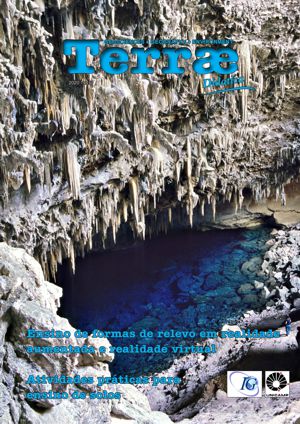Abstract
The relevance of laboratory practices in the development of scientific attitudes and competences in schools has led to the implementation of different strategies and development of new didactic approaches. Ichnological experiments make it possible to analyze diverse sets of interrelated scientific data, such as: morphological structure of the organism, movement patterns, quality of produced pathways and substrate composition. The analysis of the impressions produced allows us to identify how different environmental conditions, such as humidity and soil compaction, can affect the preservation and structure of traces left by different organisms in the environment. The proposal seeks to increase practical activity by carrying out an experiment that uses four different arthropods, with different body shapes in the adult stage – centipede (Scolopendra subspinipes), beetle (Hylobiu sabietis), wolf spider (Lycosa sp.) and millipede (Jullus sp.), as well as highlight the relationship between biological and environmental aspects, making it possible to stimulate teaching and learning, emphasizing the relevance of the soil in the structuring of the biosphere.
References
Alf, R. M. (1968). A spider trackway from the Coconino Formation, Seligman, Arizona. Bulletin of the Southern California Academy of Sciences, 67(2), 125-128. Disponível em: https://scholar.oxy.edu/scas/vol67/iss2/9/.
Anderson, J. M. (2009). Why should we care about soil fauna? Pesquisa de Agropecuária Brasileira, 44(8), 835-842. doi: 10.1590/S0100-204X2009000800006.
Brand, L. R. & Kramer, J.(1996). Underprints of vertebrate and invertebrate trackways in the Permian Coconino sandstone in Arizona. Ichnos, 4(3), 225-230. doi: 10.1080/10420949609380129.
Carvalho, M. C. N. & Carvalho, R. I. N. (2002). Terrários: Ciência e Arte. Curitiba, Ed. UFPR. 67p.
Chamberlain, C. K. (1975). Recent lebensspuren in nonmarine aquatic environments. In: Frey, R. W. (ed.). (1975). The Study of Trace Fossils: A Synthesis of Principles, Problems and Procedures in Ichnology. New York, Springer-Verlag. p. 431-58.
Davis, R. B., Minter, N. J., & Braddy, S. J. (2007). The neoichnology of terrestrial arthropods. Palaeogeography, Palaeoclimatology, Palaeoecology, 255, 284-307. doi: 10.1016/j.palaeo.2007.07.013
Donovan, S. K. (1994). The Palaeobiology of Trace Fossils.New York, Wiley-Blackwell. 604p.
Elders, C. A. (1975). Experimental approaches in neoichnology. In: Frey, R.W. (ed.) (1975). The Study of Trace Fossils: A Synthesis of Principles, Problems and Procedures in Ichnology. New York, Springer-Verlag. p. 513-36.
Frey, R. W., & Pemberton, S. G. (1991). The ichnogenus Schaubcylindrichnus: morphological, temporal, and environmental significance. Geological Magazine, 128(6), 595-602. doi: 10.1017/s0016756800019713.
Gaillard, C., Hantzpergue, P., Vannier, J., Margerard, A. L., & Mazin, J. M. (2005). Isopod trackways from the CrayssacLagerstätte, Upper Jurassic, France. Palaeontology, 48, 947-962. doi: 10.1111/j.1475-4983.2005.00502.x.
Hasiotis, S.T. (2003). Complex ichnofossils of solitary and social soil organisms: understanding their evolution and roles in terrestrial paleoecosystems. Palaeogeography, Palaeoclimatology, Palaeoecology, 192, 259-320. doi: 10.1016/s0031-0182(02)00689-2.
Johnson, E. W., Briggs, D. E. G., Suthren, R .J., Wright, J., & Tunnicliff, S. P. (1994). Non-marine arthropod traces from the subaerial Ordovician Borrowdale Volcanic Group, English Lake District. Geological Magazine, 131, 395-406. doi: 10.1017/s0016756800011146.
Manton, S. M. (1972). The evolution of arthropodan locomotory mechanisms: Part 10. Locomotory habits, morphology and evolution of hexapod classes. Zoological Journal of the Linnean Society, 51, 257-375. doi: 10.1111/j.1096-3642.1973.tb00790.x.
Margerard, A. L. (2000). L'isopode Archaeoniscus (Crustacea) du Jurassique supérieur O-européen (France, Grande-Bretagne): anatomie, ichnologie, modélisationbioméchanique. Lyon, Université de Lyon, France. 245p. (MSc dissertation).
Martin, A. J., & Rindsberg, A. K. (2006). Arthropod tracemakers of Nereites? Neoichological observations of juvenile limulids and their paleoichnological applications. In: Miller, W. (Ed.). (2006). Trace Fossils: Concepts, Problems, Prospects. Amsterdam, Elsevier. p. 478-491.
Metz, R. (1987). Insect traces from nonmarine ephemeral puddles. Boreas, 16, 189-195. doi: 10.1111/j.1502-3885.1987.tb00770.x.
Minter, N. J., Krainer, K., Lucas, S. G., Braddy, S. J.& Hunt, A. P. (2007). Palaeoecology of an Early Permian playa lake trace fossil assemblage from Castle Peak, Texas, USA. Palaeogeography, Palaeoclimatology, Palaeoecology, 246, 390-423. doi: 10.1016/j.palaeo.2006.10.009.
Sadler, C. J. (1993). Arthropod trace fossils from the Permian DeChelly Sandstone, northeastern Arizona. Journal of Paleontology, 67, 240-249. doi: 10.1017/s0022336000032169.
Walker, S .E., Holland, S .M. & Gardiner, L. (2003). Coenobichnus currani (new ichnogenus and ichnospecies): fossil trackway of a land hermit crab, Early Holocene, San Salvador, Bahamas. Journal of Paleontology, 77, 576-582. doi: 10.1666/0022-3360(2003)077<0576:ccniai>2.0.co;2 .
Wolters, V. (2000). Invertebrate control of soil organic matter stability. Biology and Fertility of Soils, 31, 1-19. doi: 10.1007/s003740050618.

This work is licensed under a Creative Commons Attribution-NonCommercial 4.0 International License.
Copyright (c) 2020 Terrae Didatica


